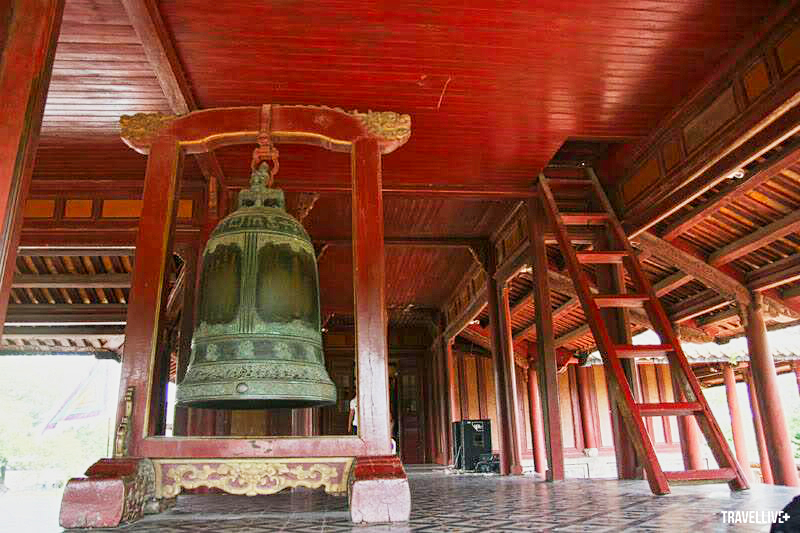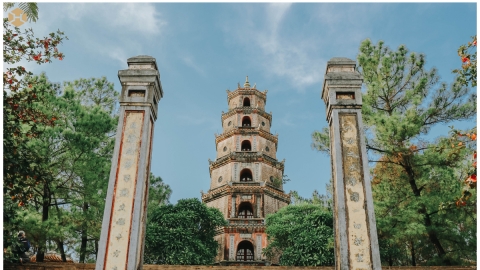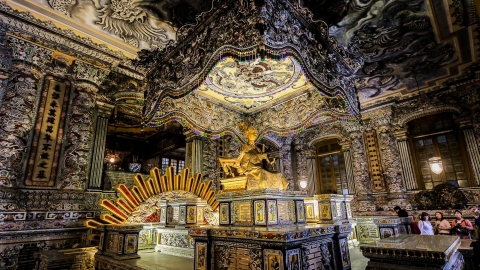Hue Citadel is an almost square citadel, each side is about 2.5 km, the front is slightly curved following the shape of the Perfume River flowing in front of the citadel.
Inside the Citadel is a smaller citadel, called the Imperial Citadel - a citadel with a front and back facade 622 m long, and two side facades 604 m long; this is where the important agencies of the royal court are located.
Inside the Imperial City is another smaller citadel, the Forbidden City - the front and back sides are 324 m long, the two sides are 290 m long; this is where the royal family lives. People also call the Imperial City (including the Forbidden City) the Imperial City.
The city wall
In mid-1802, King Gia Long ascended the throne, he immediately thought of building a new capital in Hue. In 1803 and 1804, the planning (selecting the location, surveying the field, locating the ground, planning the architecture, etc.) was carried out by King Gia Long himself and his high-ranking mandarin Nguyen Van Yen. The construction of Hue Citadel began in 1805 under the reign of King Gia Long, the construction process was not continuous, lasting until 1832 under the reign of King Minh Mang when it was basically completed.
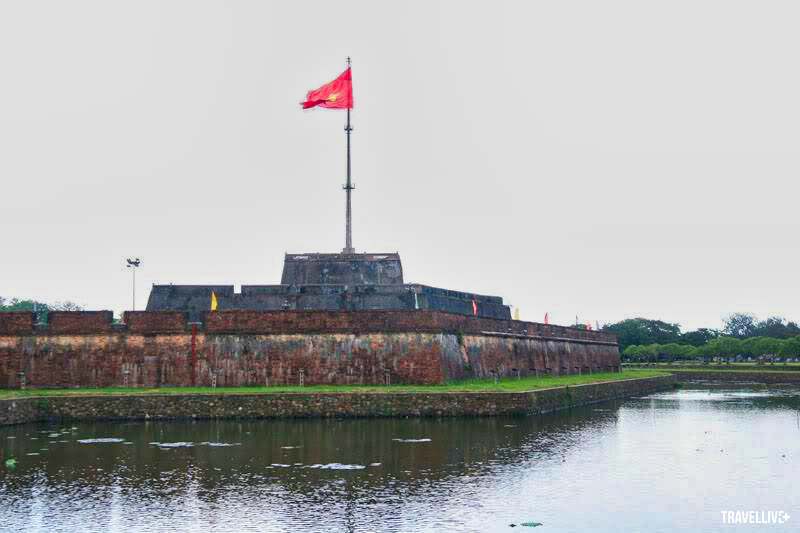
The outer wall is 6.6 m high, the top layer has loopholes.
In April 1805, the construction of the Citadel began. About 30,000 workers were mobilized by the royal court. First, they dug a river around the land planned for the Citadel, then used that land to build an earthen wall.
According to the bookDai Nam Thuc Luc Chinh BienSeeing that the work of building the Citadel was extremely difficult and arduous, King Gia Long paid the soldiers very generously. The King also paid attention to the weather and set regulations on working hours to facilitate the soldiers and avoid negative effects on their health. The King also ordered the Imperial Hospital to be divided into many locations on the construction site to take care of the health of the soldiers who were digging the Citadel.
The work of building the earthen wall lasted from April to August 1805. It was not until 1818 that King Gia Long ordered the brickwork to be built on the wall. They started using bricks to cover the front and right (West) sides, then King Gia Long died in 1820 so the work was temporarily suspended, until 1822 (during the reign of King Minh Mang) when they continued to cover the back (North) and left (East) sides.
This outermost wall is 21.5 m thick, including 18.5 m of earthen walls, 2 m thick brick layer on the outside, 1 m thick brick layer on the inside. The wall is built in steps from the outside in. The outer brick layer is 6.6 m high, while the inner brick layer is only 2.1 m high.
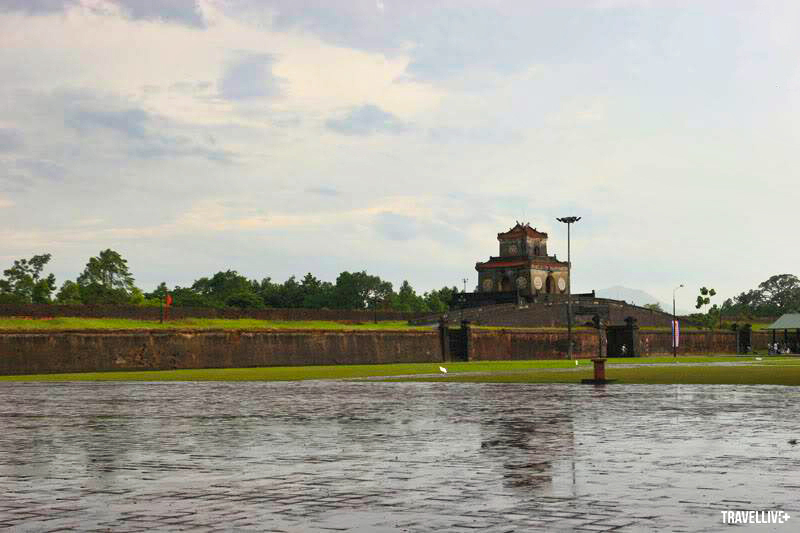
The wall surface gradually decreases in level, the innermost level is only 2.1 m high.
In 1831-1832, King Minh Mang ordered the construction of additional shooting walls on the outermost wall of the citadel (building high brick walls, leaving gaps for hiding inside to shoot out, like loopholes). By 1832, the construction of the citadel wall of Hue Citadel was considered complete. The perimeter of this outermost wall was more than 10.5 km.
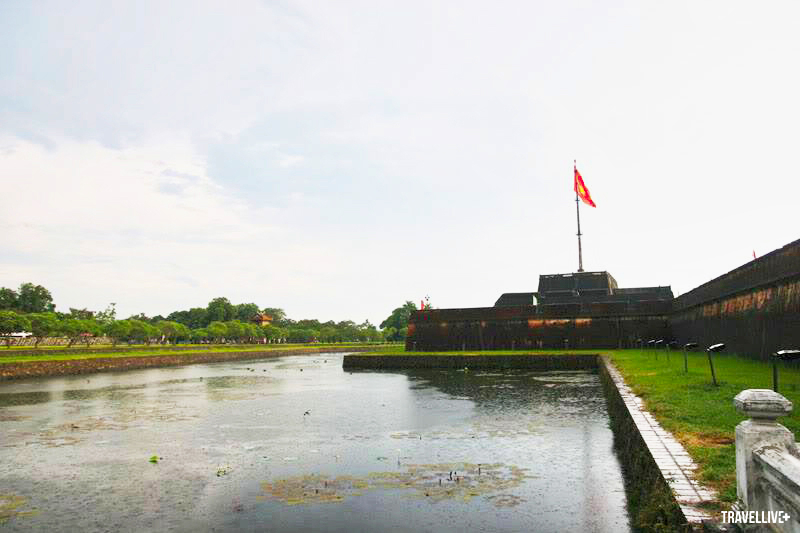
Ho Thanh Ha, the section in front of Ky Dai
The canal surrounding the outside of the citadel (to get soil to build the citadel), called Ho Thanh Ha, is more than 20 meters wide, forming a moat to protect the Citadel. Ho Thanh Ha is connected to the Huong River outside, and to the Ngu Ha canal inside the Citadel, to regulate the water flow inside the Citadel.
Inside the citadel wall is a series of structures of Hue Citadel, starting from the Flag Tower built right on the citadel wall, followed by the Imperial Citadel - where the important agencies of the royal court are located - surrounded by a smaller citadel wall, with the main gate being a famous structure: Ngo Mon.
Flag Tower
The flagpole is located in the middle of the front of the Citadel, built by King Gia Long in 1807 and renovated by King Minh Mang in 1829, 1831, and 1840.

Flag Tower seen from the Perfume River, in front of the Citadel is Phu Van Lau
The flagpole was built in three overlapping floors, the lower floor is wide, the upper floors are gradually narrower. The floors are pentagonal with the base facing the inside of the Citadel, the two small sides creating an angle facing the outside of the Perfume River.
The total height of the three platforms is 17.5 m. The original flagpole was made of wood and was erected in the middle of the top platform. In 1904, a big storm broke the flagpole, so King Thanh Thai ordered it to be replaced with a new one made of cast iron.
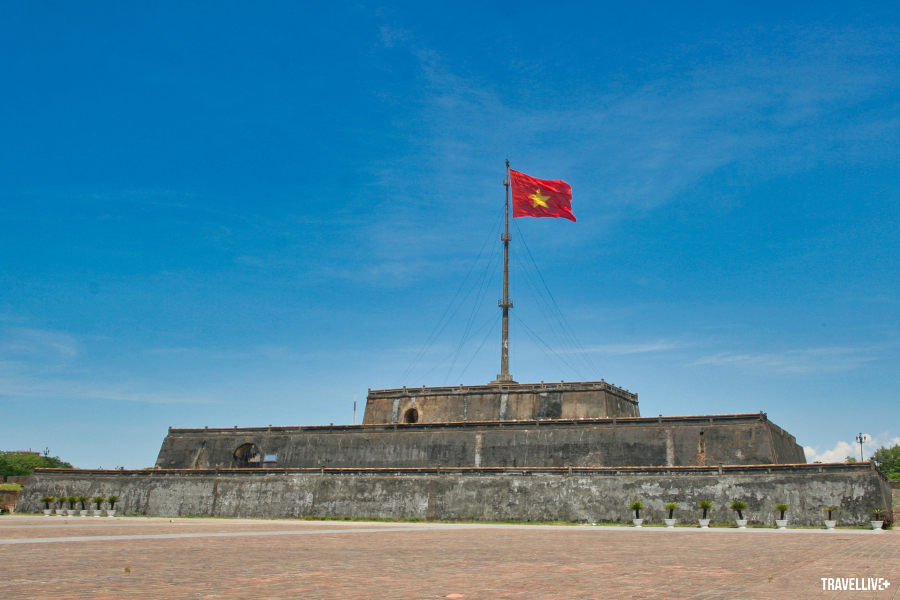
Flag Tower seen from Ngo Mon Gate
In 1947, during the war, the flagpole collapsed again. In 1948, a new reinforced concrete pole was erected, which remains to this day. The flagpole is 37 m high, and the total height from the ground to the top of the flagpole is 54.5 m.
Imperial City
The Imperial Citadel is the second layer of the citadel inside the Citadel, construction began in 1804, and within it is the most important area of the Citadel.
The citadel wall was built of bricks, 4.16 m high, 1.04 m thick. The perimeter of the Imperial Citadel wall is about 2.5 km, each side has a gate. The southern gate is Ngo Mon, the northern gate is Hoa Binh, the eastern gate is Hien Nhon, the western gate is Chuong Duc.
Outside the citadel there is a moat system surrounding the Imperial Citadel, the moat is 16 m wide, 4 m deep, lined with stone, called Ngoai Kim Thuy.
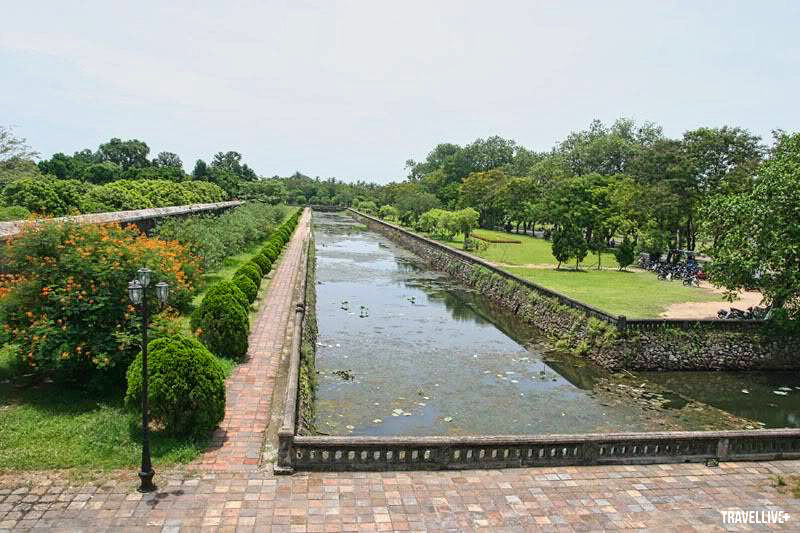
Ngoai Kim Thuy, the road area and ramparts of the Imperial Citadel
Between the Imperial Citadel ramparts and the surrounding Ngoai Kim Thuy moat is a 13-meter-wide open space, called the defense area. It is explained that, in case of an attack, if the citadel wall collapses, bricks will fall into this open space instead of filling the moat (making it easier for enemy infantry to penetrate).
Ngo Mon Gate - Ngu Phung Tower
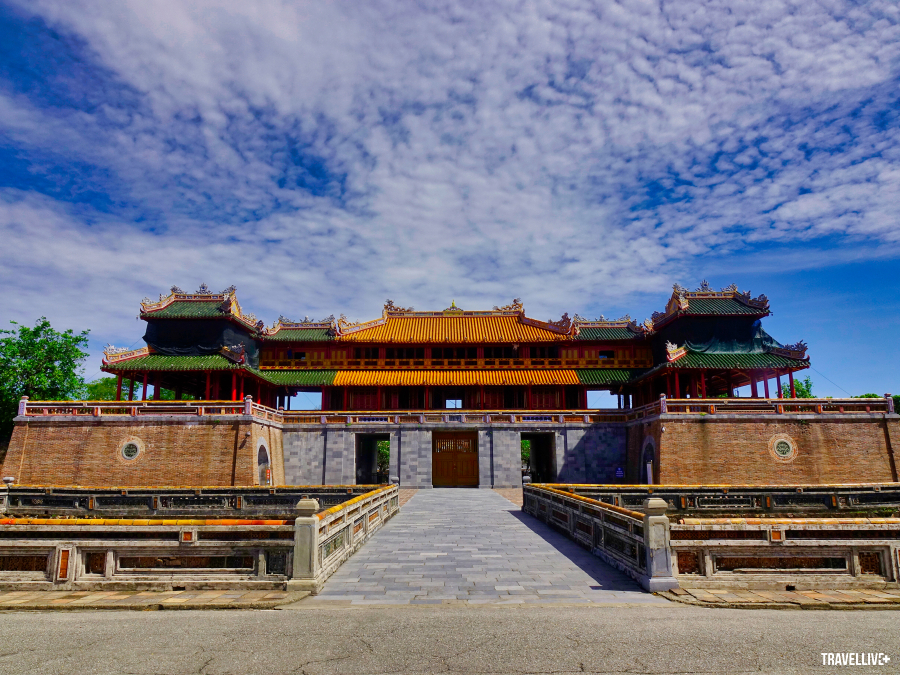
Ngo Mon - the main southern gate of the Imperial Citadel
Ngo Mon is the main gate of the Imperial City, located in the South. Initially, King Gia Long built a small platform above Ngo Mon called Nam Khuyet Platform. In 1833, King Minh Mang demolished Nam Khuyet Platform and rebuilt a new Ngo Mon as majestic as it is today.
Ngo Mon consists of two parts: the platform - gate below, and Ngu Phung tower above. The platform is nearly 5 meters high, U-shaped, attached to the wall, the base is more than 57 meters long, the side of the U is more than 27 meters long.
The "U-shaped bottom" has 3 gates to the Imperial Citadel, built of stone, the purlins on the gate arch are made of brass (to support the weight of the Ngu Phung tower above) with a cross section of 15cmx12cm, and the ceiling is covered with thin copper plates.

Ngo Mon - the gate reserved for the king - in the middle, painted yellow
The main gate, Ngo Mon, is the widest and highest, reserved only for the king (so in the past it was almost always closed). The two side gates, Ta Giap Mon and Huu Giap Mon, are lower, reserved for civil and military mandarins accompanying the king's royal procession.
On both sides of the U-shaped wing, there are two gates, Ta Dich Mon and Huu Dich Mon, running along the length of the U-shaped wing, which are the entrances for elephants, horses and soldiers. Passing through Ngo Mon is entering the Imperial City - also known as Dai Noi.

Left - Right translation gate on both sides
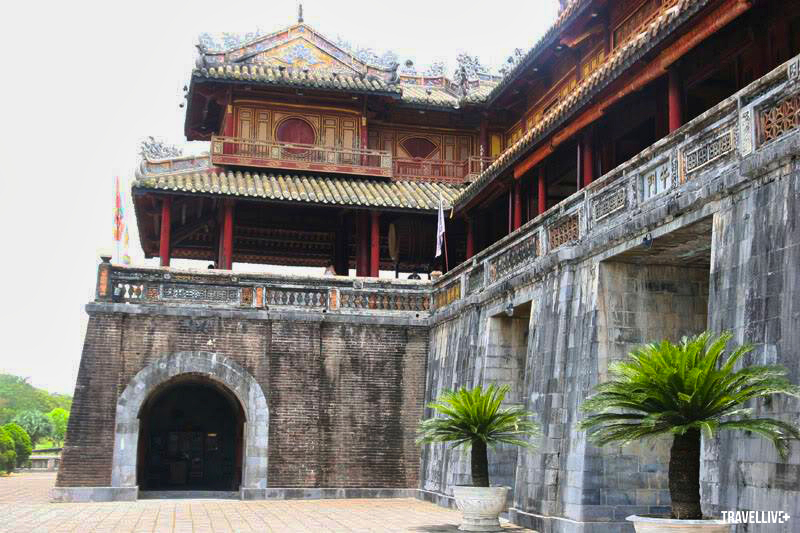
Left - Right translation gate on both sides
On the upper side of Ngo Mon platform is Ngu Phung tower - a 2-storey wooden tower consisting of a total of 100 ironwood pillars, of which 48 pillars span both floors - a ceremonial platform used to hold a number of major annual ceremonies of the ancient Nguyen Dynasty. The way up to Ngu Phung tower is the stairs built on both sides behind the U-shaped wing of Ngo Mon.
The floor of the building is raised 1.15 m higher than the gate platform, also running in a U shape. Ngu Phung Tower has two floors, the lower floor is large, the upper floor is small, with 13 compartments structured into a frame also in the shape of a U like the platform. The roof of the lower floor is connected, running around to cover the corridors (in the shape of a U). The roof of the upper floor is divided into 9 large and small sets, different heights. On the top of the roof sets are decorated with many phoenixes, so the building is called Ngu Phung Tower.
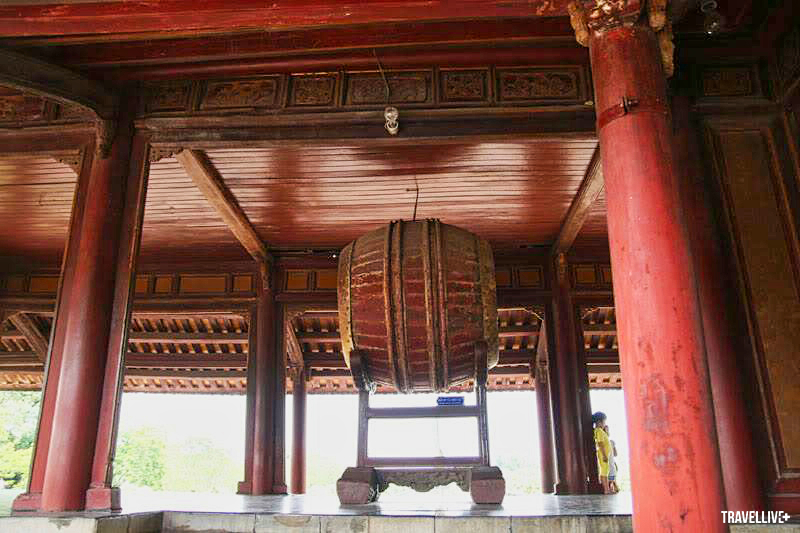
The big drum on the right side of Ngu Phung tower
On the right side of the Ngu Phung floor, there is a large drum, on the left side is a large bronze bell, cast in the third year of Minh Mang (1822). The bell is exquisitely cast, the bell stand is also carved with a dragon head.
On the body of the bell is engraved an inscription, bookFrom Ngo Mon to Thai Hoa Palace(Tre Publishing House, 1994), summary translation:
When the Emperor had been in power for three years, he thought of casting a large bell to express his voice, and ordered talented officials to write it down in writing. I secretly thought that a bell was an instrument that emitted the sound of vital energy. This sound was used in court meetings and banquets. Its resonance moved people's hearts to absorb the virtue of Heaven and Earth without counting their own merits... That was the proof of prosperity in times of peace. Now, we, the ministers, clasp our hands in worship and respectfully present this inscription:
The Holy Emperor Suffers
Hundred light spells
Now the bell is cast
All in accordance with the procedure
No display, no drawing
Wide sound
Distant sound, near clear
Enjoy peace together
A thousand years later
Enjoy the success together
